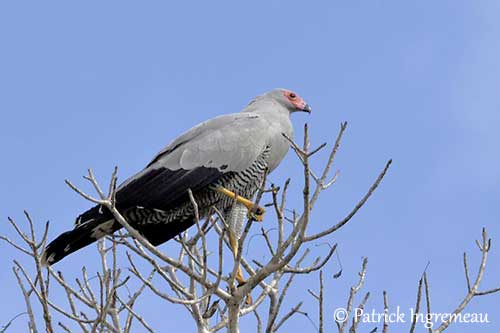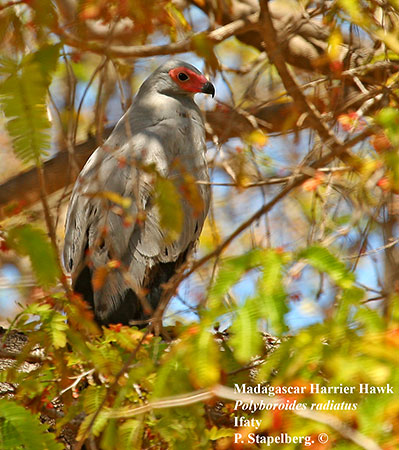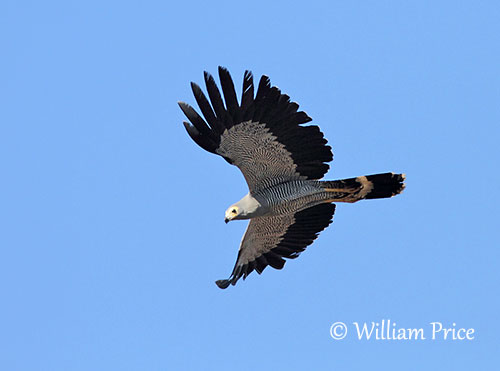
Fr: Gymnogène de Madagascar
Ang: Madagascar Harrier-Hawk
All: Madagaskarhöhlenweihe
Esp: Aguilucho caricalvo malgache
Ita: Gimnogene del Madagascar
Nd: Holenkiekendief
Sd: madagaskarklätterhök
Mal: andrasabe, Fihiaka, Voromboakoana
Photographers:
Jean Michel Fenerole
Photos d’Oiseaux du monde
Patrick Ingremeau
TAMANDUA
William Price
PBase-tereksandpiper & Flickr William Price
Dubi Shapiro
Dubi Shapiro Photo Galleries
Philip Stapelberg
GALLERY
Alan & Ann Tate
AA Bird Photography
Text by Nicole Bouglouan
Sources:
HANDBOOK OF THE BIRDS OF THE WORLD Vol 2 by Josep del Hoyo-Andrew Elliot-Jordi Sargatal - Lynx Edicions - ISBN: 8487334156
BIRDS OF PREY OF AFRICA AND ITS ISLANDS by Alan and Meg Kemp - Struik Publishers - ISBN: 1770073698
Birds of Madagascar and the Indian Ocean Islands Par Roger Safford, Adrian Skerrett, Frank Hawkins – ISBN: 1472924118, 9781472924117- Editeur: Bloomsbury Publishing, 2015
Global Raptor Information Network - Working to Conserve Birds of Prey in nature
Wikipedia, the free encyclopaedia
SORA- Diet of the Madagascar Harrier-Hawk, Polyboroides radiatus, in southeastern Madagascar
Raptors of the World Par James Ferguson-Lees,David A. Christie
Related article: Harrier-hawks - Harriers - Crane Hawk
Madagascar Harrier-Hawk
Polyboroides radiatus
Accipitriformes Order – Accipitridae Family
INTRODUCTION:
The Madagascar Harrier-Hawk is endemic to Madagascar where it frequents forests, woodlands and plantations of exotic trees. It is uncommon on the deforested central plateau.
This raptor is a slender, pale grey hawk with quite different shape from other raptors of the island. The long wings almost reach the tail tip and the legs are long and thin.
The Madagascar Harrier-Hawk is very similar to the African Harrier-Hawk (P. typus), but the present species is paler above and has narrower barring below. However, both species share some similar feeding behaviour such as using the feet to probe and remove prey from hidden holes, crevices and weaver’s nests.
This species is fairly common in wooded areas throughout the restricted range. It has currently stable population and is not globally threatened.

DESCRIPTION OF THE BIRD:
Biometrics:
Length: 57-68 cm
Wingspan: 155 cm
The Madagascar Harrier-Hawk adult has grey plumage overall but paler than P. typus, and with brown wash on the upperparts. We can see some black spots on scapulars and greater wing-coverts. The flight feathers are black with narrow white tips. The long tail is black with broad white bar at mid-length and narrow white tip.
On the underparts, lower breast and underwing coverts are white and finely barred black, narrower than P. typus.
Head, chin, throat and upper breast are grey. The bare, yellow facial skin becomes pink and red as the breeding season is in progress.
The bill is black. The eyes are dark brown. Long, thin, bare legs and small feet are yellow.
The adult female is slightly larger than male and has less (or no) black spots on wing-coverts.
The juvenile is brown above with spotted head and neck. Back and wings are “scaled” due to the white feather tips. Flight and tail feathers are dark brown, the latter with broad, paler grey-brown bars.
The underparts appear pale, mainly white, with conspicuous spots, streaks and bars. On the head, the facial skin is mostly grey.
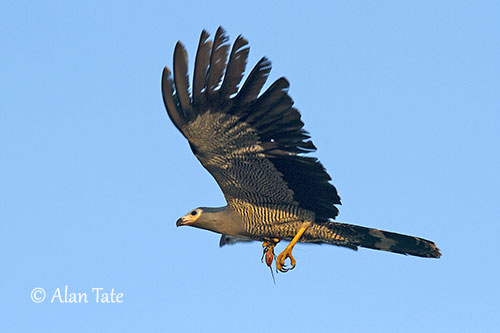
It probes and removes prey from holes or weaver’s nests, thanks to its long, “double-jointed” legs. It climbs around tree trunks and branches with flapping wings to keep the balance while peering into holes and crevices.
It also hunts in flight by floating slowly between trees or by soaring while searching for prey on trees or on the ground. It may rob the nests of other raptors too. It also hunts by walking on the ground and it spends long periods perched within cover.
During the breeding season, the Madagascar Harrier-Hawk performs aerial displays including mutual circling and sky-dancing. They are monogamous, and both mates tend the young, but the male brings the food at nest.
The Madagascar Harrier-Hawk is sedentary and probably nomadic according to the season.
It has buoyant flight on long broad, rounded wings, and it soars easily with distinctive eagle-like appearance.
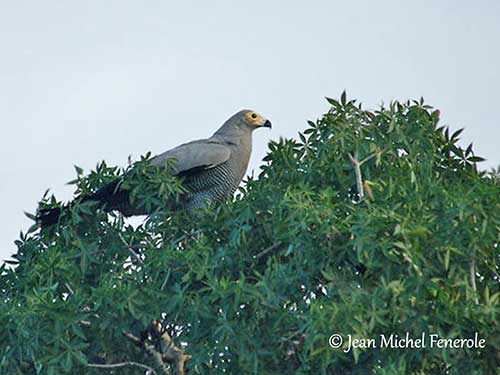
REPRODUCTION OF THIS SPECIES:
The laying occurs in October and the breeding season extends from late August/September to November/December, sometimes until February.
The nest is mainly built by the female, a bulky stick nest placed in fork in tall tree between 10 and 30 metres above the ground, and lined with green leaves. It may be occasionally built on cliff ledge. However, the nests are often close to villages with weaver colonies. The same nest is reused in several following years.
The female lays two buff eggs with darker markings, usually at 2-4 days interval. She incubates during 39-40 days. She is fed by the male during this period, and the male sometimes incubates too.
The hatching is asynchronous and usually, the smaller chick does not survive more than one week. The female feeds and broods the surviving chick with the prey brought at nest by the male. The young fledges about 50 days after hatching, but it still depends on adults for food for some times.
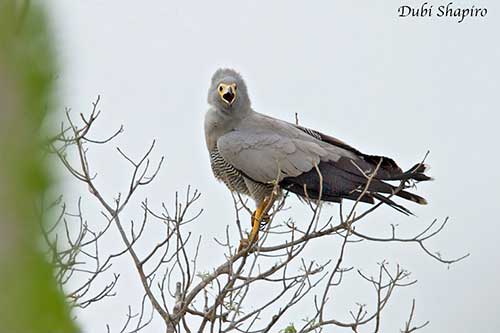
RANGE:
The Madagascar Harrier-Hawk is present throughout Madagascar, but it is rare on the deforested central plateau.
HABITAT:
The Madagascar Harrier-Hawk frequents a variety of habitats, and especially forest and woodlands up to 2,000 metres of elevation, but mainly below 1,300 metres. It can be seen in spiny desert scrub, exotic plantations, wooded savannas and sometimes at wetland edges.
CALLS AND SONGS: SOUNDS BY XENO-CANTO
The Madagascar Harrier-Hawk gives distinctive, drawn-out, typical “keeeoow” calls. During the breeding season, it produces a long shrill “weeeee-eer” of 1-2 seconds and descending at the end. This call is given both in flight and perched.
BEHAVIOUR IN THE WILD:
The Madagascar Harrier-Hawk feeds on a wide variety of prey including small mammals (lemurs and flying foxes Pteropus rufus), birds and their nestlings, reptiles, amphibians and large insects.
